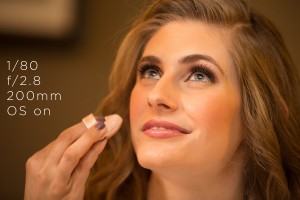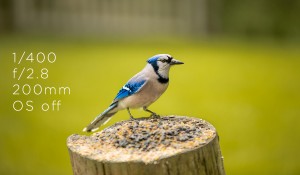The Sigma 70-200 is an amazing lens, but just how amazing?
Just recently I read a lens review where the person writing the review said, “Sharpness is not something I normally notice on a lens.” To this point all I can say is, wait, what?
How can any photographer, specifically one who is writing a review of a lens, not notice how sharp a lens is? Maybe I’m wrong, but when shopping for a new lens, isn’t the sharpness of a lens just as important as it’s focal length?
For this review, I am talking specifically about the sharpness. Even more specifically, the sharpness at it’s widest aperture setting of f/2.8. I am also testing it’s sharpness with OS (optical stabilization) both on and off.
First, let’s take a look at a real world application for a lens like the 70-200 — A wedding. Weddings are a great test bed because you need a lens that can give you a sharp, great looking image in conditions you often can’t plan for. A common rule when shooting with a telephoto lens is to have your shutter speed match, if not exceed the focal length of your lens. So, if shooting at 200mm, you’d ideally have a shutter speed around 1/250. A rule like this is easy to follow if you can plan for the situation you’re shooting in, but when working a fast paced job, like a wedding, you may not always be able to comply with a rule like this. That’s why a lens with optical stabilization (also known as IS, or VC) can be so important.
Here are two sample images illustrating the sharpness of the Sigma 70-200 with OS on. This first sample is an uncropped photo, straight from the camera. Even at this size, not zoomed in, it’s apparent how clean the details are. It’s even more amazing when you consider this image was shot at 1/80th of a second, zoomed in at 200mm. That’s way below the threshold for steady, clean shooting. Shooting a lens at this speed, at this focal length would normally mean your photos would suffer from a bad case of the jitters.
Now let’s zoom in and look at some detail from this photo with stabilization turned on. You can easily see just how amazing this lens is. The details, like the lines around the eyes, and the eyelashes, are damn near perfectly sharp. And don’t forget, this is wide open at f/2.8. Historically a lens’ widest aperture setting is not where it performs at its best in terms of sharpness, but here we can see the Sigma performing astonishingly well.
So, we’ve shown that the Sigma’s sharpness with OS enabled is amazing, but does that mean it’ll function equally well when you have enough light to shoot without OS? Let’s find out!
In this first image, we can see that our subject (the bird) is acceptably sharp at f/2.8. For reference, the focus point was placed over the bird’s eye, just as it was for our subject in the wedding photo above.
This is an extreme crop. In fact, I am zooming in around 25% further than the photo’s max native resolution.
It’s here, at this extreme zoom, that we see just how awesome the Sigma’s sharpness really is. The fidelity of the Sigma 70-200mm lens means you can scale your photos a bit beyond 100% and still retain respectable sharpness. In practical terms, this means higher quality prints at larger sizes, and the ability to really dig into your photos to create a better composition in post.
One last thought on image quality concerns color fringing. I’ve read elsewhere that Canon lenses tend to fringe with a magenta tint, and Sigmas tend to fringe with a greenish tint. That green fringe is evident here. I can also say through experience that the amount of color fringing on the Sigma is less than it is on my Canon lenses. This only applies to the Canon lenses I own, and the amount of difference in fringing varies from lens to lens.
So, here’s where I, the reviewer, try to summarize my thoughts on the subject. Before I do that, however, let me just address one argument that many photographers have made since the beginning of time. That is, simply, that you should never waste money on a non-brand lens.
When I first used this lens 2 weeks ago, it only took a few hours before someone said, “That’s not a Canon lens, but hey, it’s cheaper, right?”
“Cheaper, and perhaps better.”, I replied. The guy who made the comment looked shocked. I’m sure he either felt I was a first year newb photographer, or that I was just crazy. But, when I turned the camera around and showed him some of the photos I was taking he simply nodded, shut his mouth and sat down in his chair. Why? Because the proof is in the pudding; you can’t dispute results.
I’ve owned a 70-200 Canon lens for over 6 years and I’ve loved it every time I’ve used it. The cold, hard truth however, is that this Sigma is better. Oh yea, it’s cheaper too.





